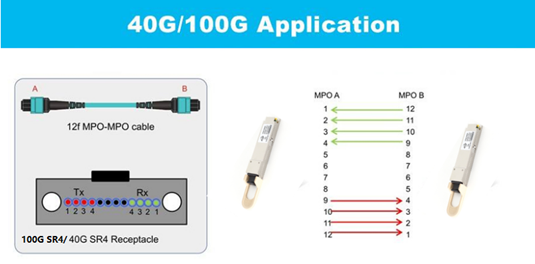
While 100G and higher is the next big milestone for very large data centers, 40G is likely to remain on the market forever. Traditional enterprise three-tier data centers have low density requirements and limited budgets, so they can be directly upgraded to 40G on top of 10G. The 10G-40G-100G network upgrade path mainly USES the 10G equipment and wiring system deployed in the early stage to upgrade the network, in which 40G is realized through four 10G parallel channels and 100G through 10 10G parallel channels. Because the network upgrade path is based on a 10G single-channel implementation, a large number of fiber hoppers are required for deployment, resulting in more complex and costly cabling. At the same time, when want to realize long distance transmission, 40G QSFP + optical module (e.g., 40G + LR4 QSFP optical module) through WDM technology to integrate the four 10 g channel into an even road, especially for long distance transmission QSFP + optical module, such as + ER4 QSFP optical module, because of this, the QSFP + optical module has been high cost, which leads to higher cost when choosing the network upgrade path.

40G Ethernet was developed in 2008 and officially approved in 2010. 40G Ethernet adopts four data transmission channels, each of which has a transmission rate of about 10Gbps, realizing 40Gbit/s Ethernet frame transmission with higher efficiency and lower management cost. The 40G runs on a four-channel small pluggable (QSFP+) device and supports high bandwidth applications such as online video on demand. 40G switches can be used as converters or leaf switches in large data center rooms, and as core or ridge switches in small and medium-sized enterprise networks.
Nowadays, with the rapid development of 40G Ethernet, many small and medium-sized enterprises will choose it as a solution in network deployment. However, the current 40G series products are always at a high price and have limited business capacity, so their future development will be limited. Moreover, because 100G Ethernet is better than 40G Ethernet in terms of the uniformity of technical solutions, the follow-up of standards and the development of industrial chain, many operators skip the deployment of 40G Ethernet and choose to deploy 100G Ethernet directly. With the continuous development of 100G Ethernet technology, the price of 100G series products will gradually decrease, and in the near future, the price of 100G series products will be at the same level as that of 40G series products. As far as the current market is concerned, 100G Ethernet occupies the dominant position in the high-rate network market, greatly inhibiting the development of 40G Ethernet.
